Instructions PDBI calculation
生物大分子的计算模拟方法

生物大分子的计算模拟方法生物大分子是由生物大分子结构单元组成的,这些结构单元通常是蛋白质、核酸、多糖和脂质,对于了解基因的表达、酶的催化机制和药物设计等方面有着重要的意义。
传统的实验方法仍然是生物大分子研究中重要的手段,但随着计算机技术的迅速发展,计算模拟方法也逐渐成为了解和研究生物大分子结构和功能的重要手段。
生物大分子的计算模拟方法主要分为分子动力学模拟、蒙特卡罗方法和量子化学计算。
其中,分子动力学模拟是最常用的计算模拟方法之一。
它通过数值模拟的方式模拟体系内分子之间相互作用和随时间演化的过程,可以得到系统的动力学和结构信息。
与实验方法相比,分子动力学模拟具有许多优点,例如可以探测特殊环境下生物大分子的结构和功能、可以更细致地了解生命系统中分子的动态和稳态性质、可以控制和调节分子之间的相互作用等。
在分子动力学模拟中,数学模型主要是牛顿定律。
模拟开始时,需要确定体系的初态,然后在规定的时间内,跟踪体系中分子之间的相互作用和运动状态,并计算每个分子的位置、速度和能量等。
模拟结束后,可以得到体系中每个分子的位置和能量变化趋势,从而了解不同时间点分子的运动规律和稳态特性。
除了分子动力学模拟之外,蒙特卡罗方法也是一种常见的计算模拟方法。
蒙特卡罗方法源于统计物理学中对随机过程的研究,其主要思想是根据统计规律随机生成分子的位置和姿态,然后利用能量函数计算每个位置和姿态的稳定性,选择稳定性较高的位置和姿态作为下一步的模拟对象。
蒙特卡罗方法模拟分子动力学的优点在于可以更精确地计算体系的相互作用和稳态,但计算时间通常较长。
量子化学计算作为生物大分子计算模拟方法中的新兴方向,将化学物理学中量子力学的原理引入到计算模拟中,可以精确计算体系的电荷分布、分子轨道等信息。
相比起传统的分子动力学模拟和蒙特卡罗方法,量子化学计算有着更高的精确度和更细致的分子结构和能量计算。
生物大分子计算模拟方法的进一步发展,需要精确描述分子和离子之间的相互作用,并增强模型与实验之间的一致性。
运算类编程实验深圳大学
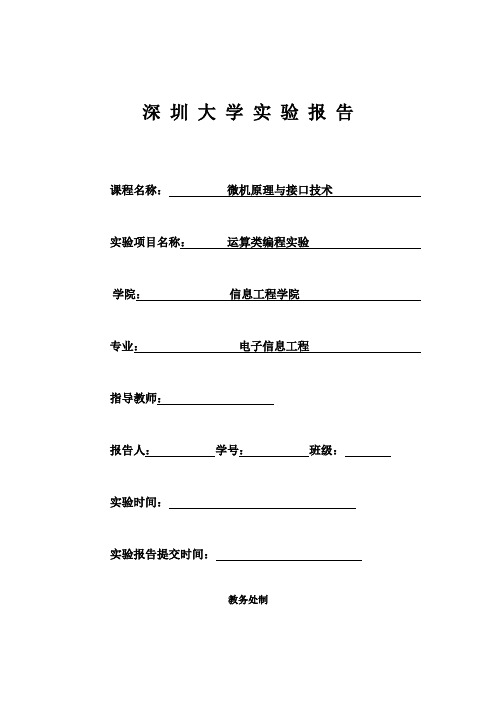
CODEENDS
END START
实验步骤:
(1)编写程序,经编译、链接无误后装入系统。
(2)程序装载完成后,点击‘变量区’标签将观察窗切换到变量监视窗口。
(3)点击 ,将变量XH,XL,YH,YL,ZH,ZL添加到变量监视窗中,然后修改XH,XL,YH,YL的值,如图2.13所示,修改XH为0015,XL为65A0,YH为0021,YL为B79E。
DATAENDS
CODESEGMENT
ASSUME CS:CODE, DS:DATA
START:MOV AX, DATA
MOV DS, AX
MOV AX, XL
ADD AX, YL;X低位加Y低位
MOV ZL, AX;低位和存到Z的低位
MOV AX, XH
ADC AX, YH;高位带进位加
MOV ZH, AX;存高位结果
MOV DS, AX
MOV AH, 00H
SAHF
MOV CX, 0002H
MOV SI, OFFSET X
MOV DI, OFFSET Z
A#43;02H]
DAS
PUSHF
AND AL, 0FH
POPF
MOV [DI], AL
INC DI
INC SI
LOOP A1
JMP START;设置断点,以方便观察变量。
CODEENDS
END START
实验步骤
(1)输入程序,编译、链接无误后装入系统。
(2)点击 将变量X,Y,Z添加到变量监视窗中,并为X,Y赋值,假定存入40与12的BCD码,即X为0400,Y为0102。
(3)在JMP START语句行设置断点,然后运行程序。
生物大分子相互作用的计算模拟方法
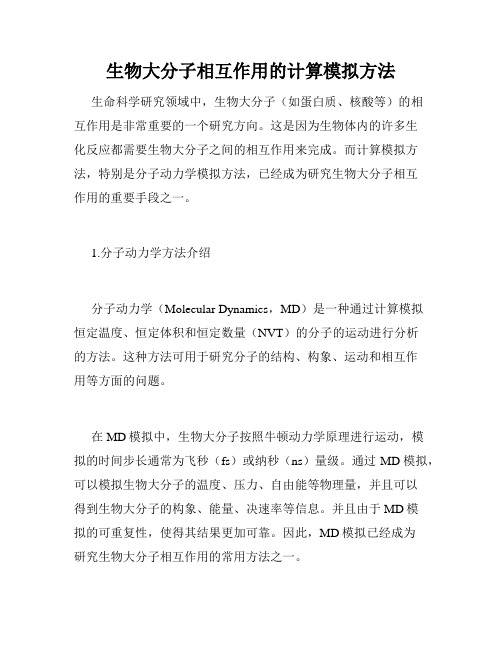
生物大分子相互作用的计算模拟方法生命科学研究领域中,生物大分子(如蛋白质、核酸等)的相互作用是非常重要的一个研究方向。
这是因为生物体内的许多生化反应都需要生物大分子之间的相互作用来完成。
而计算模拟方法,特别是分子动力学模拟方法,已经成为研究生物大分子相互作用的重要手段之一。
1.分子动力学方法介绍分子动力学(Molecular Dynamics,MD)是一种通过计算模拟恒定温度、恒定体积和恒定数量(NVT)的分子的运动进行分析的方法。
这种方法可用于研究分子的结构、构象、运动和相互作用等方面的问题。
在MD模拟中,生物大分子按照牛顿动力学原理进行运动,模拟的时间步长通常为飞秒(fs)或纳秒(ns)量级。
通过MD模拟,可以模拟生物大分子的温度、压力、自由能等物理量,并且可以得到生物大分子的构象、能量、决速率等信息。
并且由于MD模拟的可重复性,使得其结果更加可靠。
因此,MD模拟已经成为研究生物大分子相互作用的常用方法之一。
2.分子动力学与分子静力学的比较分子动力学和分子静力学是两种常用的计算模拟方法。
尽管它们都用于研究生物大分子的相互作用,但它们的特点不同。
在分子静力学模拟中,大分子通常被视为静态的,而不是通过运动来进行性质分析。
分子静力学模拟适用于稳态环境下的大分子性质研究,如蛋白质稳定性等。
然而,在研究生物大分子相互作用的问题上,分子动力学模拟的能力更强。
分子动力学模拟允许模拟生物大分子的动态行为,如柔性分子的运动、生物分子的构形变化等。
这使得分子动力学模拟能够研究生物大分子在尺度和时间上的动态行为和动力学特性,而这些特性常常是生物大分子相互作用的关键。
3.分子动力学模拟中的参数设置正确的模拟参数设置对于MD模拟结果的可靠性和准确性至关重要。
下面介绍一些常见的参数设置方法。
3.1 模拟盒子生物大分子模拟通常需要放置在一个模拟盒子中,以模拟生物大分子的溶液环境。
盒子的大小必须足够容纳生物大分子和溶液。
盒子的形状可以为正方体或长方体。
半经验方法简介

对于复杂的大分子的计算,目前由于受到计算机条件的限制,从头算还有困难,故往往采用各种近似方法.在半经验方法的计算中,从电子结构的一些试验资料估计最难以计算的一些积分.当使用模型法计算分子电子结构时,不再从原始的完正Hamilton量出发,而是从最简单的模型Hamilton量出发.这种Hamiltom 量只是粗略地考虑了分子中相互作用,通常包含一些待定的参数.
半经验法引入的化简极大地简化了必须的计算工作量,并且可能计算一些更复杂分子的电子结构.这种计算所得到的资料带有定性的和半定量的特性.实际上,如果该方法用于一些它力所能及的问题.计算结果的精确度通常足以说明所研究分子的性质,肯定或否定某中物理化学假定.
尽管在半经验方法中依据试验值对一些计算所进行的参数化补偿了计算方案的不足.但是,却不能苛求半经验方法面面俱到,使分子的各种电子性质的计算都有同样好的结果.因此,通常保证分子的某些电子结构性质好的计算方案对于另外一些电子结构性质有可能导出不适当的结果.于是,对于每种半经验方法,可以因各类具体参数化方案的不同而变的多样化.
在相当大程度上,每类参数化都是局限于分子的一些性质或一定种类分子的计算.因此,半经验方法不是以描述分子的全部特性为基本内容,而是着眼于比较同系物的某些性质.当足以正确地引入参数时,可以得到复杂化合物电子结构的定性或定量的资料,同系物分子的某些特性的变化规律,以及建立他们同试验观测的物理与化学性质的联系,显然,这些问题都是现代化学关注的中心.。
Calc 计算器手册 第 B 部分 函数说明说明书
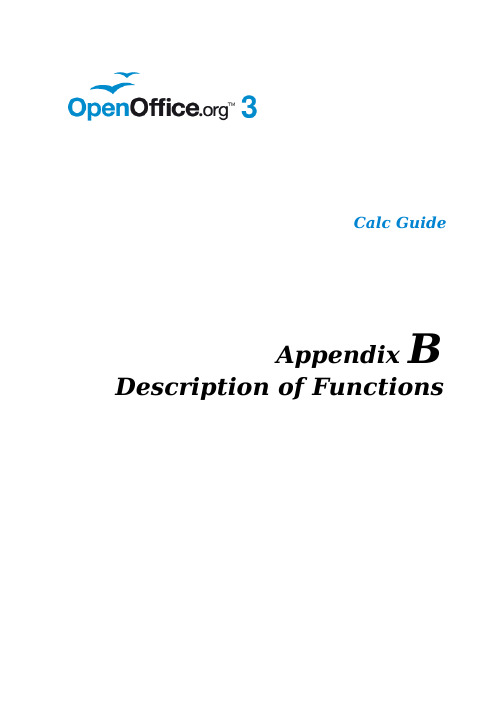
Calc GuideAppendix B Description of FunctionsCopyrightThis document is Copyright © 2005–2011 by its contributors as listed below. You may distribute it and/or modify it under the terms of either the GNU General Public License (/licenses/gpl.html), version 3 or later, or the Creative Commons Attribution License (/licenses/by/3.0/), version 3.0 or later.All trademarks within this guide belong to their legitimate owners.ContributorsMagnus Adielsson Richard BarnesPeter Kupfer Iain RobertsJean Hollis WeberFeedbackPlease direct any comments or suggestions about this document to:********************************.orgAcknowledgmentsMuch credit for this work is due to the unselfish efforts of Bill Wilson and Dr. Bob Smith.Publication date and software versionPublished 26 January 2011. Based on 3.3.Note for Mac usersSome keystrokes and menu items are different on a Mac from those used in Windows and Linux. The table below gives some common substitutions for the instructions in this chapter. For a more detailed list, see the application Help.You can downloadContentsCopyright (2)Note for Mac users (2)Functions available in Calc (4)Terminology: numbers and arguments (4)Mathematical functions (4)Financial analysis functions (9)A note about dates (9)A note about interest rates (9)Statistical analysis functions (19)Date and time functions (27)Logical functions (30)Informational functions (31)Database functions (33)Array functions (34)Spreadsheet functions (36)Text functions (40)Add-in functions (43)Functions available in CalcCalc provides all of the commonly used functions found in modern spreadsheet applications. Since many of Calc’s functions require very specific and carefully calculated input arguments, the descriptions in this appendix should not be considered complete references for each function. Refer to the application Help or the OOo wiki for details and examples of all functions. On the wiki, start with/wiki/Documentation/How_Tos/Calc:_Functions_liste d_by_categoryOver 300 standard functions are available in Calc. More can be added through extensions to Calc (see Chapter 14). The following tables list Calc’s functions organized into eleven categories.Note Functions whose names end with _ADD are provided for compatibility with Microsoft Excel functions.They return the same results as the corresponding functions in Excel (without the suffix), which though they may be correct, are not based on international standards.T erminology: numbers and argumentsSome of the descriptions in this appendix define limitations on the number of values or arguments that can be passed to the function. Specifically, functions that refer to the following arguments may lead to confusion.•Number_1; number_2;... number_30•Number 1 to 30• a list of up to 30 numbersThere is a significant difference between a list of number s (or integers) and the number of arguments a function will accept. For, example the SUM function will only accept a maximum of 30 arguments. This limit does NOT mean that you can only sum 30 numbers, but that you can only pass 30 separate arguments to the function. Arguments are values separated by semi-colons, and can include ranges which often refer to multiple values. Therefore one argument can refer to several values, and a function that limits input to 30 arguments may in fact accept more then 30 separate numerical values.This appendix attempts to clarify this situation by using the term arguments, rather than any of the other phrases.Mathematical functionsTable 1: Mathematical functionsFinancial analysis functionsA note about datesDate values used as parameters for Calc’s financial functions must be entered in a specific manner. For example, a date (entered in the US form) must be surrounded by quotes and with periods separating each value. To represent August 6, 2004, or8/6/04, you would enter “08.06.2004”. If you do not enter the date values as required by the function, you will not get the correct results. Date formats are locale specific; check the Help for the acceptable formatting.A note about interest ratesYou can enter interest rates in either of two ways:•As a decimal. To enter an interest rate as a decimal, divide it by 100 before entering it into a function. For example, to compute a loan with a 3.25%interest rate, enter .0325 into the function.•As a percentage. To enter an interest rate as a percentage, type in the interest rate followed by the % key. For example, to compute a loan with a 3.25%interest rate, enter 3.25% into the function.If you enter it as 3.25, the function will treat it as a 325% interest rate.Accounting systems vary in the number of days in a month or a year used in calculations. The following table gives the integers used for the basis parameter used in some of the financial analysis functions.Table 2: Basis calculation typesTable 3: Financial analysis functionsStatistical analysis functionsCalc includes over 70 statistical functions which enable the evaluation of data from simple arithmetic calculations, such as averaging, to advanced distribution and probability computations.Several other statistics-based functions are available through the Add-ins which are noted at the end of this appendix.Table 4: Statistical analysis functionsDate and time functionsUse these functions for inserting, editing, and manipulating dates and times. handles and computes a date/time value as a number. When you assign the number format “Number” to a date or time value, it is displayed as a number. For example, 01/01/2000 12:00 PM, converts to 36526.5. This is just amatter of formatting; the actual value is always stored and manipulated as a number. To see the date or time displayed in a standard format, change the number format (date or time) accordingly .To set the default date format used by Calc. go to Tools > Options > Calc > Calculate.When entering dates, slashes or dashes used as date separators may be interpreted as arithmetic operators. To keep dates from being interpreted as parts of formulas, and thus returning erroneous results, always place them in quotation marks, for example, "12/08/52".Table 5: Data and time functionsLogical functionsUse the logical functions to test values and produce results based on the result of the test.These functions are conditional and provide the ability to write longer formulas based on input or output.Table 6: Logical functionsInformational functionsThese functions provide information (or feedback) regarding the results of a test for a specific condition, or a test for the type of data or content a cell contains.Table 7: Informational functionsDatabase functionsThis section deals with functions used with data organized as one row of data for one record.The Database category should not be confused with the Base database component in . A Calc database is simple a range of cells that comprises a block of related data where each row contains a separate record. There is no connection between a database in and the Database category in OOo Calc.The database functions use the following common arguments:•Database is a range of cells which define the database.•Database_field specifies the column where the function operates on after the search criteria of the first parameter is applied and the data rows are selected.It is not related to the search criteria itself. The number 0 specifies the whole data range. To reference a column by using the column header name, placequotation marks around the header name.•Search_criteria is a cell range containing the search criteria.. Empty cells in the search criteria range will be ignored.Note All of the search-criteria arguments for the database functions support regular expressions.For example, “all.*” can be entered to find the first location of “all” followed by any characters.To search for text that is also a regular expression, precede every character with a \ character.You can switch the automatic evaluation of regular expressions on and off in T ools > Options > Calc > Calculate.Table 8: Database averageArray functions Table 9: Array functionsSpreadsheet functionsUse spreadsheet functions to search and address cell ranges and provide feedback regarding the contents of a cell or range of cells.You can use functions such as HYPERLINK() and DDE() to connect to other documents or data sources.Table 10: Spreadsheet functionsT ext functionsUse Calc’s text functions to search and manipulate text strings or character codes. Table 11: Text functionsAdd-in functions Table 12: Add-in functions。
instruction(完成)

– One operand can be memory.
Load-store architectures
– All operands are registers (except for load/store) 3
Four Architecture Classes
Instructions for Control Flow
Instruction Format
The Role of Compilers
The MIPS Architecture
Conclusion
CDA 5155 – Spring 2012
Copyright © 2012 Prabhat Mishra
Some architectures support a decimal format
Packed decimal or binary-coded decimal (BCD)
Why?
(0.10)10 = (?)2 Answers
0.10 0.0001 0.1010 0.000110011
Some decimal fractions does not have exact representation in binary.
SPEC CPU2000 on Alpha
Sign bit is not counted
© 2003 Elsevier Science (USA). All rights reserved.
12
Addressing Mode for FFT
FFTs start or end their processing with data shuffled in a particular order.
Calculation
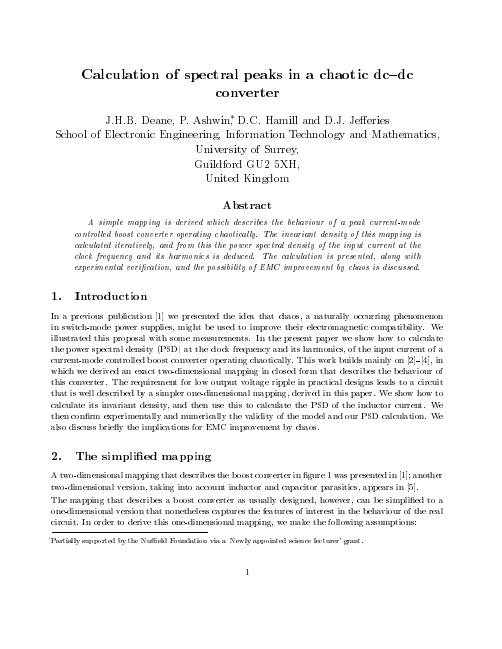
J.H.B. Deane, P. Ashwin, D.C. Hamill and D.J. Je eries School of Electronic Engineering, Information Technology and Mathematics, University of Surrey, Guildford GU2 5XH, United Kingdom
Abstract
1. Introduction
In a previous publication 1] we presented the idea that chaos, a naturally occurring phenomenon in switch-mode power supplies, might be used to improve their electromagnetic compatibility. We illustrated this proposal with some measurements. In the present paper we show how to calculate the power spectral density (PSD) at the clock frequency and its harmonics, of the input current of a current-mode controlled boost converter operating chaotically. This work builds mainly on 2]{ 4], in which we derived an exact two-dimensional mapping in closed form that describes the behaviour of this converter. The requirement for low output voltage ripple in practical designs leads to a circuit that is well described by a simpler one-dimensional mapping, derived in this paper. We show how to calculate its invariant density, and then use this to calculate the PSD of the inductor current. We then con rm experimentally and numerically the validity of the model and our PSD calculation. We also discuss brie y the implications for EMC improvement by chaos.
罗克威尔自动化SLC 500系列处理器操作系统Series C操作系统升级说明书

Release NotesSLC 5/03, SLC 5/04 Processors Operating System Series C, FRN 11 and SLC 5/05 Processors Operating System Series C, FRN 11 (for Hardware Series A/B) and FRN 13 (for Hardware Series C)Purpose of This DocumentRead this document before using SLC™ 5/03 (OS302), SLC 5/04 (OS401) Series C, FRN 11 and SLC 5/05 (OS501) Series C, FRN 13 operating system firmware. Keep this document with your SLC 500 Instruction Set Reference Manual, publication 1747-RM001.This document directs you to information on Operating System Series C, FRN 11/13 features.New FeaturesFor information on the following features, refer to the SLC 500 Instruction Set Reference Manual, publication 1747-RM001. T o view and download a PDF file, go to the Literature Library at /literature/. T o order a printed copy, contact your local Allen-Bradley Distributor or Rockwell Automation sales office.FRN 11 includes the following features:•Modbus RTU Master capability on RS232 Channel 0•PID instruction: Added rational approximation method for better calculation accuracy FRN 13(1) (SLC 5/05 Hardware Series C processors only) includes the following features:•All abovementioned features for FRN 11•Product update with upgraded hardware and new Mac ID range support.• A rare anomaly which could cause a memory loss fault has been corrected. This improves resilience to delays and errors which were seen on large area networks.RSLogix 500 programming software, version 8.10 or higher, is required to configure and program these new features.(1)FRN 12 was an internal only release.Publication 1747-RN013C-EN-P - November 2012Supersedes Publication 1747-RN013B-EN-P - December 2011Copyright © 2012 Rockwell Automation, Inc. All rights reserved. Printed in Singapore.Rockwell Automation SupportRockwell Automation provides technical information on the Web to assist you in using its products. At /support/, you can find technical manuals, a knowledge base of FAQs, technical andapplication notes, sample code and links to software service packs, and a MySupport feature that you can customize to make the best use of these tools.For an additional level of technical phone support for installation, configuration, and troubleshooting, we offer TechConnect support programs. For more information, contact your local distributor or Rockwell Automation representative, or visit /support/.Installation AssistanceIf you experience a problem within the first 24 hours of installation, please review the information that's contained in this manual. You can also contact a special Customer Support number for initial help in getting your product up and running.New Product Satisfaction ReturnRockwell Automation tests all of its products to ensure that they are fully operational when shipped from the manufacturing facility. However, if your product is not functioning and needs to be returned, follow these procedures.Documentation FeedbackYour comments will help us serve your documentation needs better. If you have any suggestions on how to improve this document, complete this form, publication RA-DU002, available at /literature/.United States or Canada1.440.646.3434Outside United States orCanada Use the Worldwide Locator at /support/americas/phone_en.html , or contact your localRockwell Automation representative.United StatesContact your distributor. You must provide a Customer Support case number (call the phone number above to obtain one) to your distributor to complete the return process.Outside United StatesPlease contact your local Rockwell Automation representative for the return procedure.Allen-Bradley, Rockwell Automation, SLC, and T echConnect are trademarks of Rockwell Automation, Inc.T rademarks not belonging to Rockwell Automation are property of their respective companies.Roc kw ell Otomasyon Ticaret A .Ş., K ar Plaza İş Mer k ezi E B lo k K at:6 34752 İçeren köy, İstanbul, T el: +90 (216) 5698400。
计算机材料模拟苯甲酰胺计算原子数目的步骤
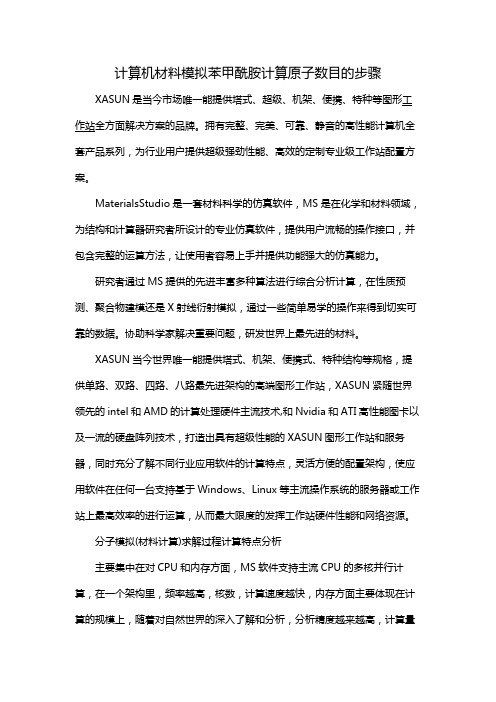
计算机材料模拟苯甲酰胺计算原子数目的步骤套产品系列,为行业用户提供超级强劲性能、高效的定制专业级工作站配置方案。
MaterialsStudio是一套材料科学的仿真软件,MS是在化学和材料领域,为结构和计算器研究者所设计的专业仿真软件,提供用户流畅的操作接口,并包含完整的运算方法,让使用者容易上手并提供功能强大的仿真能力。
研究者通过MS提供的先进丰富多种算法进行综合分析计算,在性质预测、聚合物建模还是X射线衍射模拟,通过一些简单易学的操作来得到切实可靠的数据。
协助科学家解决重要问题,研发世界上最先进的材料。
XASUN当今世界唯一能提供塔式、机架、便携式、特种结构等规格,提供单路、双路、四路、八路最先进架构的高端图形工作站,XASUN紧随世界领先的intel和AMD的计算处理硬件主流技术,和Nvidia和ATI高性能图卡以及一流的硬盘阵列技术,打造出具有超级性能的XASUN图形工作站和服务器,同时充分了解不同行业应用软件的计算特点,灵活方便的配置架构,使应用软件在任何一台支持基于Windows、Linux等主流操作系统的服务器或工作站上最高效率的进行运算,从而最大限度的发挥工作站硬件性能和网络资源。
分子模拟(材料计算)求解过程计算特点分析主要集中在对CPU和内存方面,MS软件支持主流CPU的多核并行计算,在一个架构里,频率越高,核数,计算速度越快,内存方面主要体现在计算的规模上,随着对自然世界的深入了解和分析,分析精度越来越高,计算量也越来越大,对内存的要求也在不断递增,由于求解运算过程中大量时间都在计算中,对显卡的要求自然不高,图卡主要是后期对数据的可视化有些需求,另外MS软件运算特点是将数据一次性放到内存进行密集计算,自然对硬盘外设的读写不是很频繁,传统上SATA接口也足够了,如果内存不够,虚拟内存很大的话,推荐SAS硬盘,当然将来SSD便宜下来,内存和虚拟内存的比例1:2,可以考虑采用SSD硬盘。
calculator 使用说明
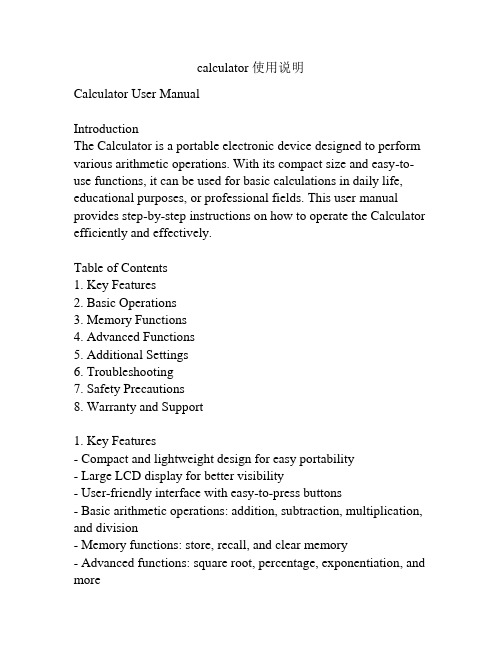
calculator 使用说明Calculator User ManualIntroductionThe Calculator is a portable electronic device designed to perform various arithmetic operations. With its compact size and easy-to-use functions, it can be used for basic calculations in daily life, educational purposes, or professional fields. This user manual provides step-by-step instructions on how to operate the Calculator efficiently and effectively.Table of Contents1. Key Features2. Basic Operations3. Memory Functions4. Advanced Functions5. Additional Settings6. Troubleshooting7. Safety Precautions8. Warranty and Support1. Key Features- Compact and lightweight design for easy portability- Large LCD display for better visibility- User-friendly interface with easy-to-press buttons- Basic arithmetic operations: addition, subtraction, multiplication, and division- Memory functions: store, recall, and clear memory- Advanced functions: square root, percentage, exponentiation, and more- Battery-powered for convenience- Auto power-off to save energy2. Basic Operations2.1 Turning On/Off the Calculator- To turn on the Calculator, press the ON/C button located at the top right corner of the device.- To turn off the Calculator, press and hold the ON/C button for a few seconds until the screen goes blank.2.2 Performing Basic Arithmetic Operations- Addition: Enter the first number using the numerical buttons, followed by the "+ (plus)" button, and then enter the second number. Press the "=" button to display the result.- Subtraction: Enter the first number, followed by the "- (minus)" button, and then enter the second number. Press the "=" button to display the result.- Multiplication: Enter the first number, followed by the "* (multiply)" button, and then enter the second number. Press the "=" button to display the result.- Division: Enter the dividend (numerator), followed by the "/ (divide)" button, and then enter the divisor (denominator). Press the "=" button to display the result.3. Memory Functions3.1 Storing a Number in Memory- After performing a calculation, press the "M+" button to store the result in memory. The result will be displayed on the screen as confirmation.3.2 Recalling a Number from Memory- Press the "MR" button to recall the number stored in memory. The number will be displayed on the screen.3.3 Clearing Memory- To clear the memory, press the "MC" button. The memory will be reset to zero.4. Advanced Functions4.1 Square Root- To calculate the square root of a number, enter the number, followed by the "√" button. Press the "=" button to display the result.4.2 Percentage- To calculate a percentage of a number, enter the number, followed by the "% (percent)" button, and then enter the percentage. Press the "=" button to display the result.4.3 Exponentiation- To calculate the exponentiation of a number, enter the base number, followed by the "x^y" button, and then enter the exponent. Press the "=" button to display the result.5. Additional SettingsThe Calculator may have additional settings depending on the model. Please refer to the specific model's user manual for detailed instructions on additional settings such as decimal places, rounding, and display options.6. TroubleshootingIf the Calculator does not turn on:- Check if the battery is inserted correctly and has sufficient charge. - Press the ON/C button firmly for a few seconds to ensure proper connection.If the Calculator displays an error message:- Check the input values and make sure they are valid for the operation.- If the error persists, reset the Calculator by removing and replacing the battery.7. Safety Precautions- Keep the Calculator away from water and other liquids to prevent damage.- Avoid exposing the Calculator to extreme temperatures or direct sunlight.- Do not disassemble the Calculator or attempt to repair it yourself. Contact customer support for assistance.8. Warranty and SupportThe Calculator comes with a limited warranty period. Please refer to the warranty card or contact customer support for warranty details and support options.ConclusionThis user manual has provided comprehensive instructions on how to operate the Calculator effectively. With its user-friendly interface, basic and advanced functions, and convenient features, the Calculator is an essential tool for anyone needing accurate andquick calculations. For any further assistance or inquiries, please refer to the support section or contact our customer support team.。
15544+自动化专业英语(习题参考解答)
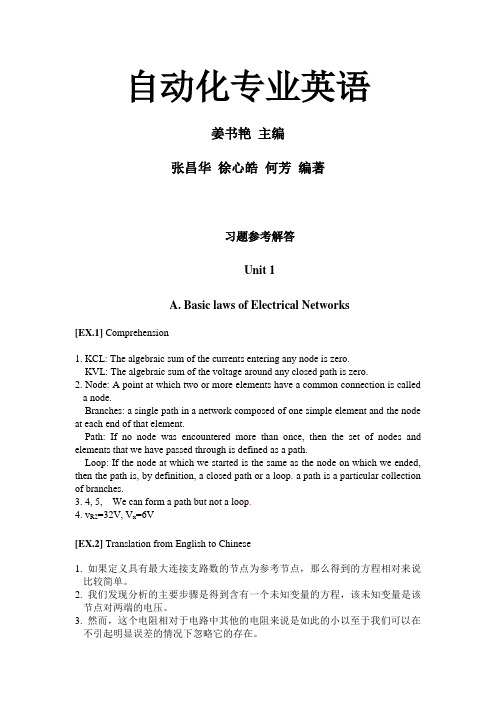
自动化专业英语姜书艳主编张昌华徐心皓何芳编著习题参考解答Unit 1A. Basic laws of Electrical Networks[EX.1] Comprehension1. KCL:The algebraic sum of the currents entering any node is zero.KVL:The algebraic sum of the voltage around any closed path is zero.2. Node: A point at which two or more elements have a common connection is calleda node.Branches: a single path in a network composed of one simple element and the node at each end of that element.Path: If no node was encountered more than once, then the set of nodes and elements that we have passed through is defined as a path.Loop: If the node at which we started is the same as the node on which we ended, then the path is, by definition, a closed path or a loop. a path is a particular collection of branches.3. 4, 5, We can form a path but not a loop.4. v R2=32V, V x=6V[EX.2] Translation from English to Chinese1. 如果定义具有最大连接支路数的节点为参考节点,那么得到的方程相对来说比较简单。
Instructional_design
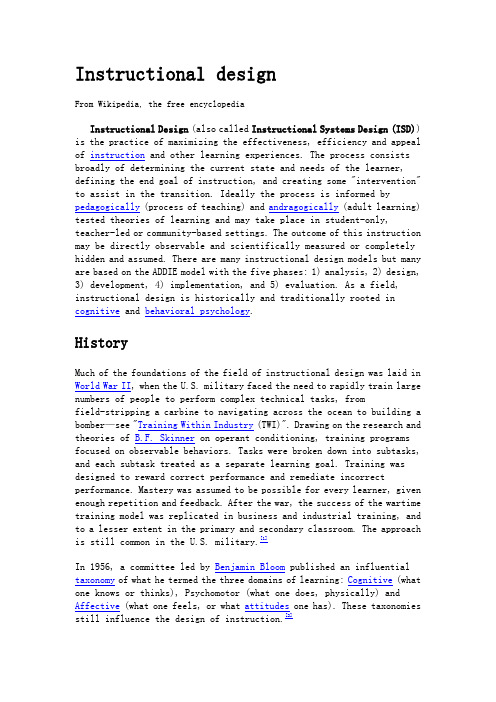
Instructional designFrom Wikipedia, the free encyclopediaInstructional Design(also called Instructional Systems Design (ISD)) is the practice of maximizing the effectiveness, efficiency and appeal of instruction and other learning experiences. The process consists broadly of determining the current state and needs of the learner, defining the end goal of instruction, and creating some "intervention" to assist in the transition. Ideally the process is informed by pedagogically(process of teaching) and andragogically(adult learning) tested theories of learning and may take place in student-only, teacher-led or community-based settings. The outcome of this instruction may be directly observable and scientifically measured or completely hidden and assumed. There are many instructional design models but many are based on the ADDIE model with the five phases: 1) analysis, 2) design, 3) development, 4) implementation, and 5) evaluation. As a field, instructional design is historically and traditionally rooted in cognitive and behavioral psychology.HistoryMuch of the foundations of the field of instructional design was laid in World War II, when the U.S. military faced the need to rapidly train large numbers of people to perform complex technical tasks, fromfield-stripping a carbine to navigating across the ocean to building a bomber—see "Training Within Industry(TWI)". Drawing on the research and theories of B.F. Skinner on operant conditioning, training programs focused on observable behaviors. Tasks were broken down into subtasks, and each subtask treated as a separate learning goal. Training was designed to reward correct performance and remediate incorrect performance. Mastery was assumed to be possible for every learner, given enough repetition and feedback. After the war, the success of the wartime training model was replicated in business and industrial training, and to a lesser extent in the primary and secondary classroom. The approach is still common in the U.S. military.[1]In 1956, a committee led by Benjamin Bloom published an influential taxonomy of what he termed the three domains of learning: Cognitive(what one knows or thinks), Psychomotor (what one does, physically) and Affective (what one feels, or what attitudes one has). These taxonomies still influence the design of instruction.[2]During the latter half of the 20th century, learning theories began to be influenced by the growth of digital computers.In the 1970s, many instructional design theorists began to adopt an information-processing-based approach to the design of instruction. David Merrill for instance developed Component Display Theory (CDT), which concentrates on the means of presenting instructional materials (presentation techniques).[3]Later in the 1980s and throughout the 1990s cognitive load theory began to find empirical support for a variety of presentation techniques.[4]Cognitive load theory and the design of instructionCognitive load theory developed out of several empirical studies of learners, as they interacted with instructional materials.[5]Sweller and his associates began to measure the effects of working memory load, and found that the format of instructional materials has a direct effect on the performance of the learners using those materials.[6][7][8]While the media debates of the 1990s focused on the influences of media on learning, cognitive load effects were being documented in several journals. Rather than attempting to substantiate the use of media, these cognitive load learning effects provided an empirical basis for the use of instructional strategies. Mayer asked the instructional design community to reassess the media debate, to refocus their attention on what was most important: learning.[9]By the mid- to late-1990s, Sweller and his associates had discovered several learning effects related to cognitive load and the design of instruction (e.g. the split attention effect, redundancy effect, and the worked-example effect). Later, other researchers like Richard Mayer began to attribute learning effects to cognitive load.[9] Mayer and his associates soon developed a Cognitive Theory of MultimediaLearning.[10][11][12]In the past decade, cognitive load theory has begun to be internationally accepted[13]and begun to revolutionize how practitioners of instructional design view instruction. Recently, human performance experts have even taken notice of cognitive load theory, and have begun to promote this theory base as the science of instruction, with instructional designers as the practitioners of this field.[14]Finally Clark, Nguyen and Sweller[15]published a textbook describing how Instructional Designers can promote efficient learning using evidence-based guidelines of cognitive load theory.Instructional Designers use various instructional strategies to reduce cognitive load. For example, they think that the onscreen text should not be more than 150 words or the text should be presented in small meaningful chunks.[citation needed] The designers also use auditory and visual methods to communicate information to the learner.Learning designThe concept of learning design arrived in the literature of technology for education in the late nineties and early 2000s [16] with the idea that "designers and instructors need to choose for themselves the best mixture of behaviourist and constructivist learning experiences for their online courses" [17]. But the concept of learning design is probably as old as the concept of teaching. Learning design might be defined as "the description of the teaching-learning process that takes place in a unit of learning (eg, a course, a lesson or any other designed learning event)" [18].As summarized by Britain[19], learning design may be associated with:∙The concept of learning design∙The implementation of the concept made by learning design specifications like PALO, IMS Learning Design[20], LDL, SLD 2.0, etc... ∙The technical realisations around the implementation of the concept like TELOS, RELOAD LD-Author, etc...Instructional design modelsADDIE processPerhaps the most common model used for creating instructional materials is the ADDIE Process. This acronym stands for the 5 phases contained in the model:∙Analyze– analyze learner characteristics, task to be learned, etc.Identify Instructional Goals, Conduct Instructional Analysis, Analyze Learners and Contexts∙Design– develop learning objectives, choose an instructional approachWrite Performance Objectives, Develop Assessment Instruments, Develop Instructional Strategy∙Develop– create instructional or training materialsDesign and selection of materials appropriate for learning activity, Design and Conduct Formative Evaluation∙Implement– deliver or distribute the instructional materials ∙Evaluate– make sure the materials achieved the desired goals Design and Conduct Summative EvaluationMost of the current instructional design models are variations of the ADDIE process.[21] Dick,W.O,.Carey, L.,&Carey, J.O.(2004)Systematic Design of Instruction. Boston,MA:Allyn&Bacon.Rapid prototypingA sometimes utilized adaptation to the ADDIE model is in a practice known as rapid prototyping.Proponents suggest that through an iterative process the verification of the design documents saves time and money by catching problems while they are still easy to fix. This approach is not novel to the design of instruction, but appears in many design-related domains including software design, architecture, transportation planning, product development, message design, user experience design, etc.[21][22][23]In fact, some proponents of design prototyping assert that a sophisticated understanding of a problem is incomplete without creating and evaluating some type of prototype, regardless of the analysis rigor that may have been applied up front.[24] In other words, up-front analysis is rarely sufficient to allow one to confidently select an instructional model. For this reason many traditional methods of instructional design are beginning to be seen as incomplete, naive, and even counter-productive.[25]However, some consider rapid prototyping to be a somewhat simplistic type of model. As this argument goes, at the heart of Instructional Design is the analysis phase. After you thoroughly conduct the analysis—you can then choose a model based on your findings. That is the area where mostpeople get snagged—they simply do not do a thorough-enough analysis. (Part of Article By Chris Bressi on LinkedIn)Dick and CareyAnother well-known instructional design model is The Dick and Carey Systems Approach Model.[26] The model was originally published in 1978 by Walter Dick and Lou Carey in their book entitled The Systematic Design of Instruction.Dick and Carey made a significant contribution to the instructional design field by championing a systems view of instruction as opposed to viewing instruction as a sum of isolated parts. The model addresses instruction as an entire system, focusing on the interrelationship between context, content, learning and instruction. According to Dick and Carey, "Components such as the instructor, learners, materials, instructional activities, delivery system, and learning and performance environments interact with each other and work together to bring about the desired student learning outcomes".[26] The components of the Systems Approach Model, also known as the Dick and Carey Model, are as follows:∙Identify Instructional Goal(s): goal statement describes a skill, knowledge or attitude(SKA) that a learner will be expected to acquire ∙Conduct Instructional Analysis: Identify what a learner must recall and identify what learner must be able to do to perform particular task ∙Analyze Learners and Contexts: General characteristic of the target audience, Characteristic directly related to the skill to be taught, Analysis of Performance Setting, Analysis of Learning Setting∙Write Performance Objectives: Objectives consists of a description of the behavior, the condition and criteria. The component of anobjective that describes the criteria that will be used to judge the learner's performance.∙Develop Assessment Instruments: Purpose of entry behavior testing, purpose of pretesting, purpose of posttesting, purpose of practive items/practive problems∙Develop Instructional Strategy: Pre-instructional activities, content presentation, Learner participation, assessment∙Develop and Select Instructional Materials∙Design and Conduct Formative Evaluation of Instruction: Designer try to identify areas of the instructional materials that are in need to improvement.∙Revise Instruction: To identify poor test items and to identify poor instruction∙Design and Conduct Summative EvaluationWith this model, components are executed iteratively and in parallel rather than linearly.[26]/akteacher/dick-cary-instructional-design-mo delInstructional Development Learning System (IDLS)Another instructional design model is the Instructional Development Learning System (IDLS).[27] The model was originally published in 1970 by Peter J. Esseff, PhD and Mary Sullivan Esseff, PhD in their book entitled IDLS—Pro Trainer 1: How to Design, Develop, and Validate Instructional Materials.[28]Peter (1968) & Mary (1972) Esseff both received their doctorates in Educational Technology from the Catholic University of America under the mentorship of Dr. Gabriel Ofiesh, a Founding Father of the Military Model mentioned above. Esseff and Esseff contributed synthesized existing theories to develop their approach to systematic design, "Instructional Development Learning System" (IDLS).The components of the IDLS Model are:∙Design a Task Analysis∙Develop Criterion Tests and Performance Measures∙Develop Interactive Instructional Materials∙Validate the Interactive Instructional MaterialsOther modelsSome other useful models of instructional design include: the Smith/Ragan Model, the Morrison/Ross/Kemp Model and the OAR model , as well as, Wiggins theory of backward design .Learning theories also play an important role in the design ofinstructional materials. Theories such as behaviorism , constructivism , social learning and cognitivism help shape and define the outcome of instructional materials.Influential researchers and theoristsThe lists in this article may contain items that are not notable , not encyclopedic , or not helpful . Please help out by removing such elements and incorporating appropriate items into the main body of the article. (December 2010)Alphabetic by last name∙ Bloom, Benjamin – Taxonomies of the cognitive, affective, and psychomotor domains – 1955 ∙Bonk, Curtis – Blended learning – 2000s ∙ Bransford, John D. – How People Learn: Bridging Research and Practice – 1999 ∙ Bruner, Jerome – Constructivism ∙Carr-Chellman, Alison – Instructional Design for Teachers ID4T -2010 ∙Carey, L. – "The Systematic Design of Instruction" ∙Clark, Richard – Clark-Kosma "Media vs Methods debate", "Guidance" debate . ∙Clark, Ruth – Efficiency in Learning: Evidence-Based Guidelines to Manage Cognitive Load / Guided Instruction / Cognitive Load Theory ∙Dick, W. – "The Systematic Design of Instruction" ∙ Gagné, Robert M. – Nine Events of Instruction (Gagné and Merrill Video Seminar) ∙Heinich, Robert – Instructional Media and the new technologies of instruction 3rd ed. – Educational Technology – 1989 ∙Jonassen, David – problem-solving strategies – 1990s ∙Langdon, Danny G - The Instructional Designs Library: 40 Instructional Designs, Educational Tech. Publications ∙Mager, Robert F. – ABCD model for instructional objectives – 1962 ∙Merrill, M. David - Component Display Theory / Knowledge Objects ∙ Papert, Seymour – Constructionism, LOGO – 1970s ∙ Piaget, Jean – Cognitive development – 1960s∙Piskurich, George – Rapid Instructional Design – 2006∙Simonson, Michael –Instructional Systems and Design via Distance Education – 1980s∙Schank, Roger– Constructivist simulations – 1990s∙Sweller, John - Cognitive load, Worked-example effect, Split-attention effect∙Roberts, Clifton Lee - From Analysis to Design, Practical Applications of ADDIE within the Enterprise - 2011∙Reigeluth, Charles –Elaboration Theory, "Green Books" I, II, and III - 1999-2010∙Skinner, B.F.– Radical Behaviorism, Programed Instruction∙Vygotsky, Lev– Learning as a social activity – 1930s∙Wiley, David– Learning Objects, Open Learning – 2000sSee alsoSince instructional design deals with creating useful instruction and instructional materials, there are many other areas that are related to the field of instructional design.∙educational assessment∙confidence-based learning∙educational animation∙educational psychology∙educational technology∙e-learning∙electronic portfolio∙evaluation∙human–computer interaction∙instructional design context∙instructional technology∙instructional theory∙interaction design∙learning object∙learning science∙m-learning∙multimedia learning∙online education∙instructional design coordinator∙storyboarding∙training∙interdisciplinary teaching∙rapid prototyping∙lesson study∙Understanding by DesignReferences1.^MIL-HDBK-29612/2A Instructional Systems Development/SystemsApproach to Training and Education2.^Bloom's Taxonomy3.^TIP: Theories4.^Lawrence Erlbaum Associates, Inc. - Educational Psychologist -38(1):1 - Citation5.^ Sweller, J. (1988). "Cognitive load during problem solving:Effects on learning". Cognitive Science12 (1): 257–285.doi:10.1016/0364-0213(88)90023-7.6.^ Chandler, P. & Sweller, J. (1991). "Cognitive Load Theory andthe Format of Instruction". Cognition and Instruction8 (4): 293–332.doi:10.1207/s1532690xci0804_2.7.^ Sweller, J., & Cooper, G.A. (1985). "The use of worked examplesas a substitute for problem solving in learning algebra". Cognition and Instruction2 (1): 59–89. doi:10.1207/s1532690xci0201_3.8.^Cooper, G., & Sweller, J. (1987). "Effects of schema acquisitionand rule automation on mathematical problem-solving transfer". Journal of Educational Psychology79 (4): 347–362.doi:10.1037/0022-0663.79.4.347.9.^ a b Mayer, R.E. (1997). "Multimedia Learning: Are We Asking theRight Questions?". Educational Psychologist32 (41): 1–19.doi:10.1207/s1*******ep3201_1.10.^ Mayer, R.E. (2001). Multimedia Learning. Cambridge: CambridgeUniversity Press. ISBN0-521-78239-2.11.^Mayer, R.E., Bove, W. Bryman, A. Mars, R. & Tapangco, L. (1996)."When Less Is More: Meaningful Learning From Visual and Verbal Summaries of Science Textbook Lessons". Journal of Educational Psychology88 (1): 64–73. doi:10.1037/0022-0663.88.1.64.12.^ Mayer, R.E., Steinhoff, K., Bower, G. and Mars, R. (1995). "Agenerative theory of textbook design: Using annotated illustrations to foster meaningful learning of science text". Educational TechnologyResearch and Development43 (1): 31–41. doi:10.1007/BF02300480.13.^Paas, F., Renkl, A. & Sweller, J. (2004). "Cognitive Load Theory:Instructional Implications of the Interaction between InformationStructures and Cognitive Architecture". Instructional Science32: 1–8.doi:10.1023/B:TRUC.0000021806.17516.d0.14.^ Clark, R.C., Mayer, R.E. (2002). e-Learning and the Science ofInstruction: Proven Guidelines for Consumers and Designers of Multimedia Learning. San Francisco: Pfeiffer. ISBN0-7879-6051-9.15.^ Clark, R.C., Nguyen, F., and Sweller, J. (2006). Efficiency inLearning: Evidence-Based Guidelines to Manage Cognitive Load. SanFrancisco: Pfeiffer. ISBN0-7879-7728-4.16.^Conole G., and Fill K., “A learning design toolkit to createpedagogically effective learning activities”. Journal of Interactive Media in Education, 2005 (08).17.^Carr-Chellman A. and Duchastel P., “The ideal online course,”British Journal of Educational Technology, 31(3), 229-241, July 2000.18.^Koper R., “Current Research in Learning Design,” EducationalTechnology & Society, 9 (1), 13-22, 2006.19.^Britain S., “A Review of Learning Design: Concept,Specifications and Tools” A report for the JISC E-learning Pedagogy Programme, May 2004.20.^IMS Learning Design webpage21.^ a b Piskurich, G.M. (2006). Rapid Instructional Design: LearningID fast and right.22.^ Saettler, P. (1990). The evolution of American educationaltechnology.23.^ Stolovitch, H.D., & Keeps, E. (1999). Handbook of humanperformance technology.24.^ Kelley, T., & Littman, J. (2005). The ten faces of innovation:IDEO's strategies for beating the devil's advocate & driving creativity throughout your organization. New York: Doubleday.25.^ Hokanson, B., & Miller, C. (2009). Role-based design: Acontemporary framework for innovation and creativity in instructional design. Educational Technology, 49(2), 21–28.26.^ a b c Dick, Walter, Lou Carey, and James O. Carey (2005) [1978].The Systematic Design of Instruction(6th ed.). Allyn & Bacon. pp. 1–12.ISBN020*******./?id=sYQCAAAACAAJ&dq=the+systematic+design+of+instruction.27.^ Esseff, Peter J. and Esseff, Mary Sullivan (1998) [1970].Instructional Development Learning System (IDLS) (8th ed.). ESF Press.pp. 1–12. ISBN1582830371. /Materials.html.28.^/Materials.htmlExternal links∙Instructional Design - An overview of Instructional Design∙ISD Handbook∙Edutech wiki: Instructional design model [1]∙Debby Kalk, Real World Instructional Design InterviewRetrieved from "/wiki/Instructional_design" Categories: Educational technology | Educational psychology | Learning | Pedagogy | Communication design | Curricula。
用计算思维指导程序设计语言课程
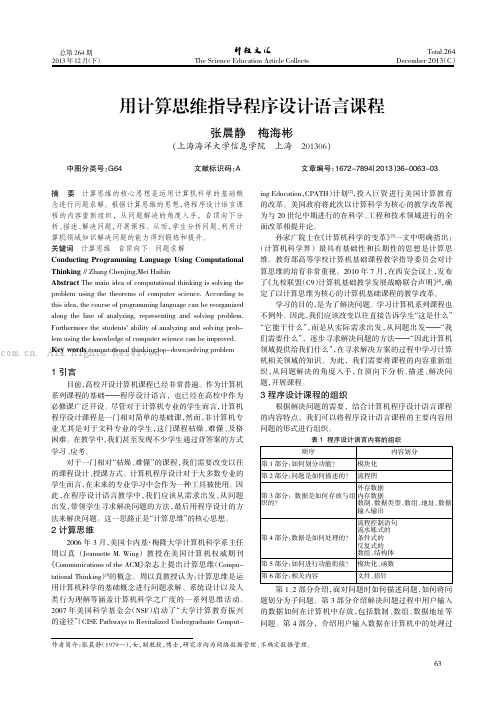
Total.264December 2013(C)The Science Education Article Collects总第264期2013年12月(下)用计算思维指导程序设计语言课程张晨静梅海彬(上海海洋大学信息学院上海201306)中图分类号:G64文献标识码:A文章编号:1672-7894(2013)36-0063-03摘要计算思维的核心思想是运用计算机科学的基础概念进行问题求解。
根据计算思维的思想,将程序设计语言课程的内容重新组织,从问题解决的角度入手,自顶向下分析、描述、解决问题,开展课程。
从而,学生分析问题、利用计算机领域知识解决问题的能力得到锻炼和提升。
关键词计算思维自顶向下问题求解Conducting Programming Language Using Computational Thinking //Zhang Chenjing,Mei HaibinAbstract The main idea of computational thinking is solving the problem using the theorems of computer science.According to this idea,the course of programming language can be reorganized along the line of analyzing,representing and solving problem.Furthermore the students'ability of analyzing and solving prob-lem using the knowledge of computer science can be improved.Key words computational thinking;top-down;solving problem1引言目前,高校开设计算机课程已经非常普遍。
蛋白质和小分子抑制剂的结合位点分析
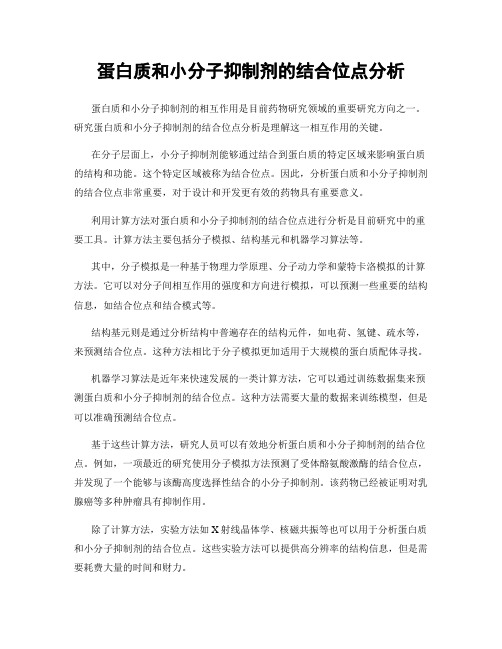
蛋白质和小分子抑制剂的结合位点分析蛋白质和小分子抑制剂的相互作用是目前药物研究领域的重要研究方向之一。
研究蛋白质和小分子抑制剂的结合位点分析是理解这一相互作用的关键。
在分子层面上,小分子抑制剂能够通过结合到蛋白质的特定区域来影响蛋白质的结构和功能。
这个特定区域被称为结合位点。
因此,分析蛋白质和小分子抑制剂的结合位点非常重要,对于设计和开发更有效的药物具有重要意义。
利用计算方法对蛋白质和小分子抑制剂的结合位点进行分析是目前研究中的重要工具。
计算方法主要包括分子模拟、结构基元和机器学习算法等。
其中,分子模拟是一种基于物理力学原理、分子动力学和蒙特卡洛模拟的计算方法。
它可以对分子间相互作用的强度和方向进行模拟,可以预测一些重要的结构信息,如结合位点和结合模式等。
结构基元则是通过分析结构中普遍存在的结构元件,如电荷、氢键、疏水等,来预测结合位点。
这种方法相比于分子模拟更加适用于大规模的蛋白质配体寻找。
机器学习算法是近年来快速发展的一类计算方法,它可以通过训练数据集来预测蛋白质和小分子抑制剂的结合位点。
这种方法需要大量的数据来训练模型,但是可以准确预测结合位点。
基于这些计算方法,研究人员可以有效地分析蛋白质和小分子抑制剂的结合位点。
例如,一项最近的研究使用分子模拟方法预测了受体酪氨酸激酶的结合位点,并发现了一个能够与该酶高度选择性结合的小分子抑制剂。
该药物已经被证明对乳腺癌等多种肿瘤具有抑制作用。
除了计算方法,实验方法如X射线晶体学、核磁共振等也可以用于分析蛋白质和小分子抑制剂的结合位点。
这些实验方法可以提供高分辨率的结构信息,但是需要耗费大量的时间和财力。
结合位点的研究一直是药物研究中的热点之一。
在未来的研究中,我们可以通过综合使用多种计算方法和实验方法来更深入地理解蛋白质和小分子抑制剂的相互作用,从而为药物研究和开发提供更加精确和高效的手段。
总而言之,在药物研究中,分析蛋白质和小分子抑制剂的结合位点是理解药物作用机制和发现新药物的关键。
生命科学中的计算模拟方法
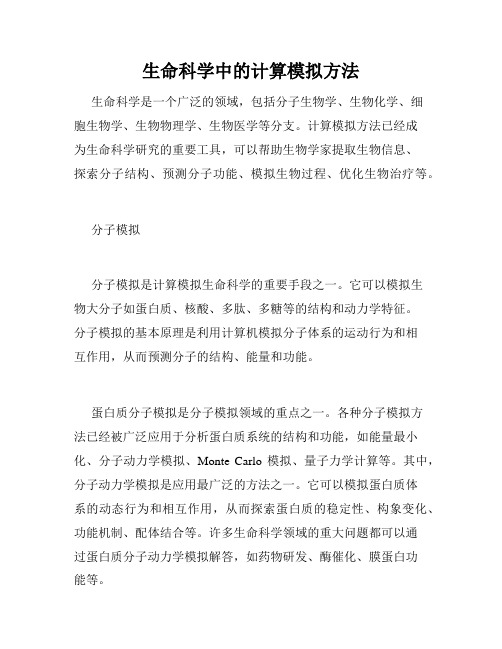
生命科学中的计算模拟方法生命科学是一个广泛的领域,包括分子生物学、生物化学、细胞生物学、生物物理学、生物医学等分支。
计算模拟方法已经成为生命科学研究的重要工具,可以帮助生物学家提取生物信息、探索分子结构、预测分子功能、模拟生物过程、优化生物治疗等。
分子模拟分子模拟是计算模拟生命科学的重要手段之一。
它可以模拟生物大分子如蛋白质、核酸、多肽、多糖等的结构和动力学特征。
分子模拟的基本原理是利用计算机模拟分子体系的运动行为和相互作用,从而预测分子的结构、能量和功能。
蛋白质分子模拟是分子模拟领域的重点之一。
各种分子模拟方法已经被广泛应用于分析蛋白质系统的结构和功能,如能量最小化、分子动力学模拟、Monte Carlo模拟、量子力学计算等。
其中,分子动力学模拟是应用最广泛的方法之一。
它可以模拟蛋白质体系的动态行为和相互作用,从而探索蛋白质的稳定性、构象变化、功能机制、配体结合等。
许多生命科学领域的重大问题都可以通过蛋白质分子动力学模拟解答,如药物研发、酶催化、膜蛋白功能等。
化学计算计算化学是利用化学原理和计算机技术进行化学研究的学科。
它包括计算机辅助药物设计、分子设计、反应机理研究、化学反应性计算、化学动力学模拟等。
计算化学在药物研发中的应用广泛,不仅可预测药物分子与靶点之间的相互作用,而且还可设计出成千上万种的候选药物分子。
这些成果已经帮助人类发现新药物,如口服抗癌药物、神经系统调节药物、心血管药物等。
计算机实验方法计算机实验方法是利用计算机模拟生物或化学实验进行研究。
人们可以利用计算机模拟各种实验,如药物分子的对接、分子动力学模拟、蛋白质折叠模拟等。
这些实验可以降低实验成本,优化实验流程,并预测实验结果。
计算机实验方法已经成为生命科学、生化研究领域中的重要研究工具,为我们提供了新的视角和研究方向。
同时,计算机实验方法也降低实验风险,避免了实验中某些不安全的操作。
总结计算模拟方法已经成为生命科学研究的重要工具,为生物学家提供了研究生命现象的一种新途径。
绝对硬度的量化探究——介绍一个计算化学实验
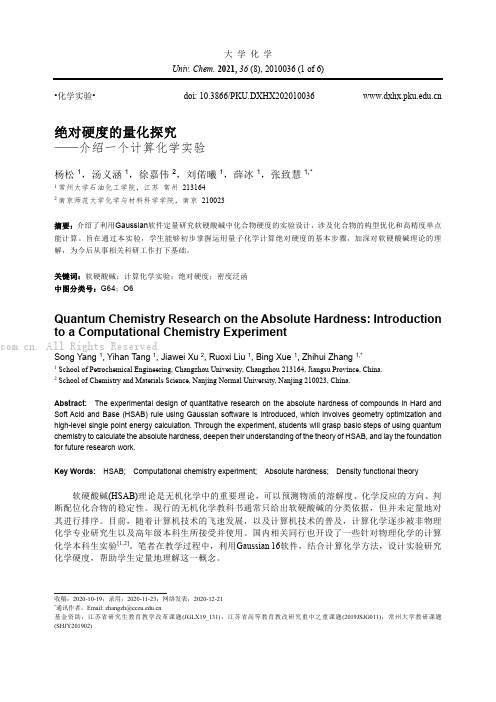
大 学 化 学Univ. Chem. 2021, 36 (8), 2010036 (1 of 6)收稿:2020-10-19;录用:2020-11-23;网络发表:2020-12-21*通讯作者,Email: zhangzh@基金资助:江苏省研究生教育教学改革课题(JGLX19_131);江苏省高等教育教改研究重中之重课题(2019JSJG011);常州大学教研课题(SHJY201902)•化学实验• doi: 10.3866/PKU.DXHX202010036 绝对硬度的量化探究——介绍一个计算化学实验杨松1,汤义涵1,徐嘉伟2,刘偌曦1,薛冰1,张致慧1,*1常州大学石油化工学院,江苏 常州 2131642南京师范大学化学与材料科学学院,南京 210023摘要:介绍了利用Gaussian 软件定量研究软硬酸碱中化合物硬度的实验设计,涉及化合物的构型优化和高精度单点能计算。
旨在通过本实验,学生能够初步掌握运用量子化学计算绝对硬度的基本步骤,加深对软硬酸碱理论的理解,为今后从事相关科研工作打下基础。
关键词:软硬酸碱;计算化学实验;绝对硬度;密度泛函中图分类号:G64;O6Quantum Chemistry Research on the Absolute Hardness: Introduction to a Computational Chemistry ExperimentSong Yang 1, Yihan Tang 1, Jiawei Xu 2, Ruoxi Liu 1, Bing Xue 1, Zhihui Zhang 1,*1 School of Petrochemical Engineering, Changzhou University, Changzhou 213164, Jiangsu Province, China.2 School of Chemistry and Materials Science, Nanjing Normal University, Nanjing 210023, China.Abstract: The experimental design of quantitative research on the absolute hardness of compounds in Hard and Soft Acid and Base (HSAB) rule using Gaussian software is introduced, which involves geometry optimization and high-level single point energy calculation. Through the experiment, students will grasp basic steps of using quantum chemistry to calculate the absolute hardness, deepen their understanding of the theory of HSAB, and lay the foundation for future research work.Key Words: HSAB; Computational chemistry experiment; Absolute hardness; Density functional theory软硬酸碱(HSAB)理论是无机化学中的重要理论,可以预测物质的溶解度、化学反应的方向、判断配位化合物的稳定性。
电信专业英语nit 6
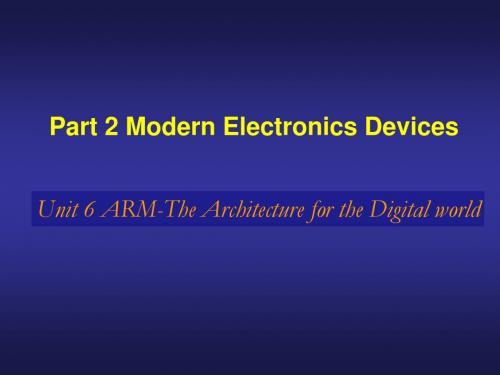
ARM Architecture
• The ARM architecture is a 32-bit advanced RISC design. The use of a simple design and a highly orthogonal, yet powerful instruction set allows it to attain good processing speeds at low power consumption. • As the demand for greater processing power in embedded devices keeps increasing, so does the popularity of ARM.
• As the foundation of the company‟s global technology network, these Partners have played a pivotal role in the widespread adoption of the ARM architecture and to date; ARM Partners have shipped more than one billion ARM microprocessor cores.
embed in dictionary
• • • • • fix or set securely or deeply; 把……牢牢地嵌入(插入、埋入) Embed a post in concrete; 把柱子嵌在水泥中; Insert and embed an object, such as a chart or an equation in a document. • 插入并嵌入一个对象,例如一个文件中的一份图表或一个 等式。
- 1、下载文档前请自行甄别文档内容的完整性,平台不提供额外的编辑、内容补充、找答案等附加服务。
- 2、"仅部分预览"的文档,不可在线预览部分如存在完整性等问题,可反馈申请退款(可完整预览的文档不适用该条件!)。
- 3、如文档侵犯您的权益,请联系客服反馈,我们会尽快为您处理(人工客服工作时间:9:00-18:30)。
Self Double Check
Calculated “Gross Profit (Insurance)” purposes should at least exceed: Sum of salaries + DB4
Corporate Treasury and Risk Management 03.12.2010
Corporate Treasury and Risk MΒιβλιοθήκη nagement 03.12.2010
HYPERION FORM PDBI
Instructions for Calculation
Property Damage and Business Interruption (PDBI) Insurance Values
Sums to be insured / Values to be reported / Rules to be followed
Variable costs are deemed to be costs relating to goods sold (all materials such as raw, process and working materials, semi-finished products, trading goods) and energy cost, together with services rendered by third parties which are in connection to production or sales (e.g. freight costs, license costs, outside services for manufacturing). Marketing-, IT-, or other administration costs are not variable costs and have not to be considered for the Gross Profit.
Calculation Scheme
* Third Party Services: Gross Turnover - Sales Deduction = Net Turnover + / - Change in Inventories ** Gross Profit (Insurance): = Value of Production - Material Costs - Energy Costs - Third Party Services * = Gross Profit (Insurance) ** Has to include the payroll of the company! No deduction from the turnover! Only if in connection with sales or production, e.g. freight costs and/or license costs
Buildings Hyperion Account YEPDB10 Installations (Plant Machinery / Equipment, incl. office equipment) Hyperion Account YEPDB20 Stocks Hyperion Account YEPDB30 Yearly average of all categories are listed below: (Values at each month end divided by 12, not to be reduced by any reserves) • • Raw materials, process materials, buy outs, including natural products at Market Values, gross, without depreciation Semi-finished products / Work in process (WIP) at Market Values of raw and process materials plus the proportionate costs of manufacturing, administration and overheads, where applicable, and the proportionate profit (Values equal to sales prices to third parties) Finished Products at Market Values (sales prices) less any expenses not incurred. Value for stock of non saleable goods must be reduced adequately. The costs of purchasing or manufacturing new articles (replacement value, gross, without depreciation) identical or similar and of the same quality to the articles possibly lost or damaged. Full rebuilding value, i.e. the costs of rebuilding / replacement to the original specification, without any reduction for depreciation.
•
Gross Profit (For insurance purposes: Gross Profit = Turnover – Variable Costs) Hyperion Account YEPDB40
Turnover is deemed to be the proceeds from the sale of goods and products and/or services rendered (without financial income). Any increases in stock of part-finished or finished articles manufactured shall be added; reductions in stock shall be deducted from this figure. The original and final stock figures are to be calculated on the same basis, e.g. before deducting any hidden reserves.
